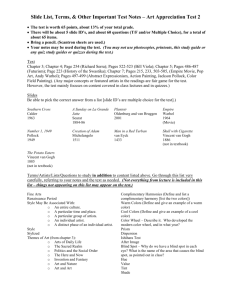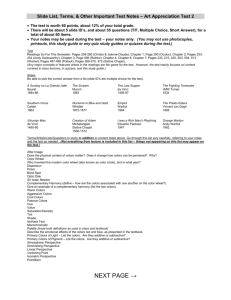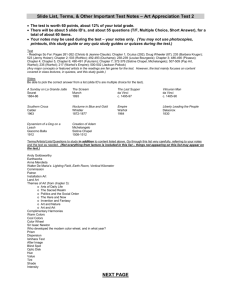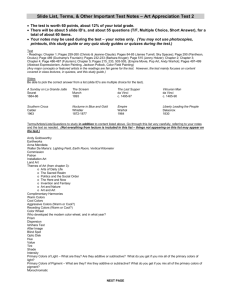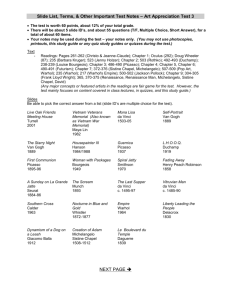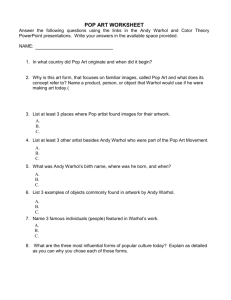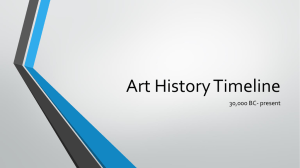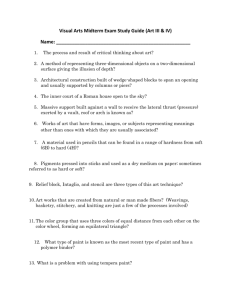Test 3 Study Guide
advertisement
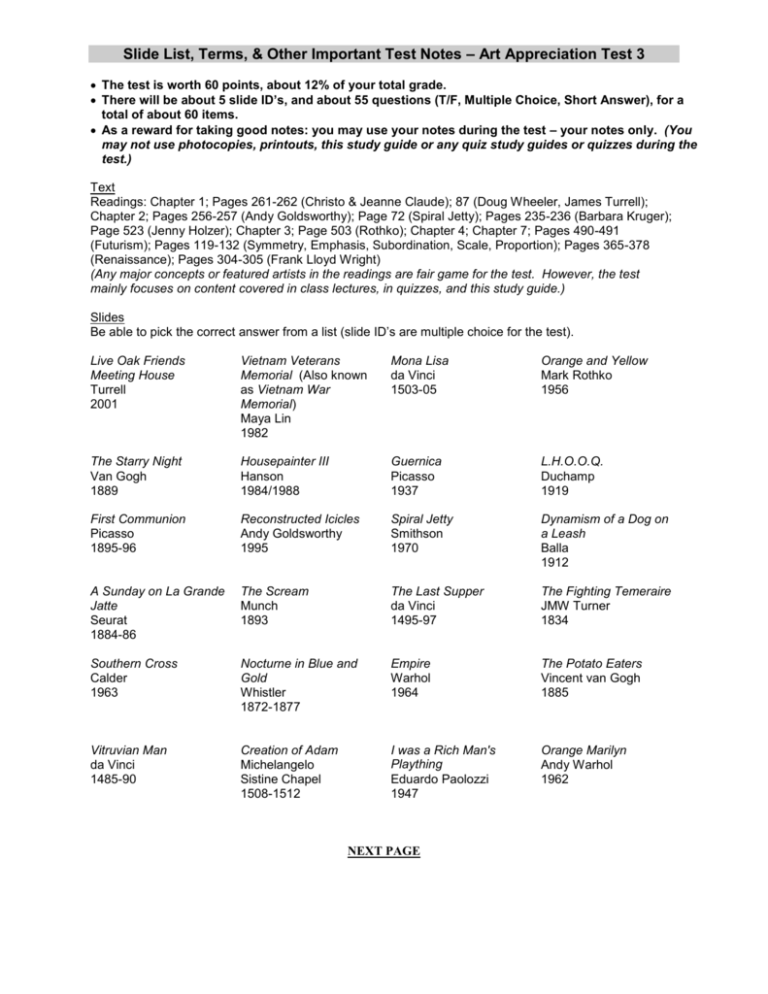
Slide List, Terms, & Other Important Test Notes – Art Appreciation Test 3 The test is worth 60 points, about 12% of your total grade. There will be about 5 slide ID’s, and about 55 questions (T/F, Multiple Choice, Short Answer), for a total of about 60 items. As a reward for taking good notes: you may use your notes during the test – your notes only. (You may not use photocopies, printouts, this study guide or any quiz study guides or quizzes during the test.) Text Readings: Chapter 1; Pages 261-262 (Christo & Jeanne Claude); 87 (Doug Wheeler, James Turrell); Chapter 2; Pages 256-257 (Andy Goldsworthy); Page 72 (Spiral Jetty); Pages 235-236 (Barbara Kruger); Page 523 (Jenny Holzer); Chapter 3; Page 503 (Rothko); Chapter 4; Chapter 7; Pages 490-491 (Futurism); Pages 119-132 (Symmetry, Emphasis, Subordination, Scale, Proportion); Pages 365-378 (Renaissance); Pages 304-305 (Frank Lloyd Wright) (Any major concepts or featured artists in the readings are fair game for the test. However, the test mainly focuses on content covered in class lectures, in quizzes, and this study guide.) Slides Be able to pick the correct answer from a list (slide ID’s are multiple choice for the test). Live Oak Friends Meeting House Turrell 2001 Vietnam Veterans Memorial (Also known as Vietnam War Memorial) Maya Lin 1982 Mona Lisa da Vinci 1503-05 Orange and Yellow Mark Rothko 1956 The Starry Night Van Gogh 1889 Housepainter III Hanson 1984/1988 Guernica Picasso 1937 L.H.O.O.Q. Duchamp 1919 First Communion Picasso 1895-96 Reconstructed Icicles Andy Goldsworthy 1995 Spiral Jetty Smithson 1970 Dynamism of a Dog on a Leash Balla 1912 A Sunday on La Grande Jatte Seurat 1884-86 The Scream Munch 1893 The Last Supper da Vinci 1495-97 The Fighting Temeraire JMW Turner 1834 Southern Cross Calder 1963 Nocturne in Blue and Gold Whistler 1872-1877 Empire Warhol 1964 The Potato Eaters Vincent van Gogh 1885 Vitruvian Man da Vinci 1485-90 Creation of Adam Michelangelo Sistine Chapel 1508-1512 I was a Rich Man's Plaything Eduardo Paolozzi 1947 Orange Marilyn Andy Warhol 1962 NEXT PAGE Terms/Artists/Lists/Questions to study in addition to content listed above. Go through this list very carefully, referring to your notes and the text as needed. (Not everything from lecture is included in this list – things not appearing on this list may appear on the test.) What do artists do?: Create places for some human purpose. Create extraordinary versions of ordinary objects. To record and commemorate. To give tangible form to the unknown. To give tangible form to feelings and ideas. To refresh our vision and help us see the world in a new way. Sky Space James Turrell Ganzfeld Pantheon Oculus Preliminary Work Site-Specific Art Public Art Ephemeral Creating and Creativity - Common Traits of Creative People. Eight common traits of creative people include: Sensitivity (heightened awareness) Flexibility (ability to adapt) Originality (ability to think abstractly) Playfulness (ability to experiment freely) Productivity (works efficiently and often!) Fluency (readiness to allow free flow of ideas) Analytical Skill (ability to solve problems) Organizational Skill (able to organize workspace, schedule, meetings, etc.) Earthworks Art What is the content of Andy Goldsworthy’s work? Commission Patron Ana Mendieta Seated Woman Holding a Fan by Picasso, 1908 Mark Rothko Color Field Painting Duane Hanson Yves Klein Klein’s Leap Into The Void IKB Pigment Jenny Holzer Holzer’s Truisms Form Subject Matter Content Christo & Jeanne Claude’s Valley Curtain Vietnam Veterans Memorial (Know the memorial and its possible purposes as described in the textbook or class. How old was Maya Lin when her design was accepted?) Aesthetics Chauvet Cave, France Walter de Maria’s Lightning Field Walter de Maria’s Earth Room Representational Representational and Naturalistic Representational and Abstract Nonrepresentational (also known as nonobjective) Barbara Kruger (Know her work. What is her goal?) Video Installation Appropriation Status Quo Know the artwork L.H.O.O.Q. Who made it? What was the artist thinking? DADA (Look it up.) Installation Art Louvre Museum (Where is it?) Pompidou Museum (Where is it?) Historical Context Physical Context Pablo Picasso’s painting Guernica: Know the historical context of the painting, as outlined in the textbook and in class. Iconography Icon Religious Icons Cultural Icons Iconoclasm Iconoclast Buddhas of Bamiyan Robert Smithson Spiral Jetty After Image Color Wheel Who invented the modern color wheel (also known as color circle), and in what year? Dispersion Prism Blind Spot Optic Disk Sir Isaac Newton Complementary Harmony (define – how are the colors associated with one another on the color wheel?) Give an example of a complementary harmony (list the two colors). NEXT PAGE NEXT PAGE Warm Colors Aggressive Colors Cool Colors Passive Colors Hue Value Saturation/Intensity Tint Shade Ishihara Test Monochromatic Palette (know both definitions as used in class and textbook) Describe the emotional effects of the colors red and blue, as presented in the textbook. Primary Colors of Light – List the colors. Are they additive or subtractive? Primary Colors of Pigment – List the colors. Are they additive or subtractive? Atmospheric Perspective Diminishing Perspective Linear Perspective Vanishing Point Isometric Perspective Pointillism Optical Color Mixture Mobile Kinetic Art The Way Things Go by Fischli and Weiss (1987) Describe the historical context of Cai Guo Qiang’s work. What is happening in the world that influences his work? Futurism What inspired the Futurists? Mandala What are Mandala’s typically made of? What do the monks do to the Mandala when they are finished creating it? Scale Small-Scale Large-Scale Richard Serra – Describe his work using our vocabulary. Is it large scale, or small scale work? Also, what happened to the work Tilted Arc? Distortion of Scale Proportion Claus Oldenburg – Describe his work using our vocabulary. Emphasis Focal Point Subordinate Elements Focal Point Subordinate Elements Symmetry Investigative Drawing Pop Art The Warhol Factory Commercial Art Fine Art How did Andy Warhol begin his career in the arts? Was he a commercial artist or a fine artist after college? Describe the Warhol film Empire – what is especially unique about it? How is it different from most movies? Warhol Factory With regard to the work Study of Human Proportions according to Vitruvius by da Vinci: What does the square around the man represent, as discussed in lecture? What does the circle around the man represent, as discussed in lecture? Jackson Pollock Automatism Action Painting Damien Hirst Stalin Painting How is paint made? What are the three main parts as described in class? Support Grounder/Primer Fresco Painting Tromp-l’oeil Encaustic Painting Tempera Painting Renaissance Man David by Michelangelo Why was producing the sculpture David considered a subtractive process? Renaissance Green Architecture Organic Architecture Prairie Style Architecture Autonomy Jay Shafer’s Tiny Homes
